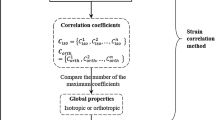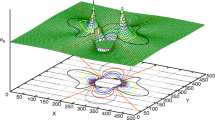Abstract
Moiré interferometry is an effective full-field deformation measurement technique and has been utilized for mechanical behavior analysis of materials and structures. For isotropic materials, Moiré patterns can be obtained by performing standard tests, such as, tensile and bending tests, to calculate the displacement and strain. Then, the mechanical properties can be characterized. However, standard tests are not sufficient to characterize the mechanical parameters of anisotropic materials due to the complexity of their material properties. Thus, in this work, Moiré interferometry was combined with the Virtual Fields Method to obtain the four in-plane elastic constants (Q11, Q22, Q12, and Q66) of orthotropic materials in the form of a diametrically compressed disk. Firstly, according to finite element method simulation results, optimized parameters can be achieved when the principal direction of the material does not coincide with the loading direction, making the loading configuration antisymmetric. Therefore, Moiré interferometry experiment was simulated to demonstrate the feasibility of measurement in the antisymmetric configuration. Finally, the Q11, Q22, Q12 and Q66 values of a unidirectional carbon fiber composite were measured in a real Moiré interferometry experiment using the proposed method, yielding results that agreed closely with those obtained using the strain gauges.


















Similar content being viewed by others
References
Post D, Han B, Ifju P (1994) High sensitivity moiré: experimental analysis for mechanics and materials. Mechanical Engineering Series, Springer-Verlag, New York
Ramulu M, Labossiere P, Greenwell T (2010) Elastic-plastic stress/strain response of friction stir-welded titanium butt joints using moiré interferometry. Opt Lasers Eng 48:385–392
Gogu C, Yin W, Haftka R, Ifju P, Molimard J, Riche RL, Vautrin A (2013) Bayesian Identification of Elastic Constants in Multi-Directional Laminate from Moiré Interferometry Displacement Fields. Exp Mech 53:635–648
Zhou MM, Xie HM, Wu LF (2016) Virtual field method coupled with moiré interferometry: Special considerations and application. Opt Lasers Eng 87:214–222
Chen TC, Ferraro CC, Yin WQ, Ishee CA, Ifju PG (2010) A novel two-dimensional method to measure surface shrinkage in cementitious materials. Cem Concr Res 40:687–698
Yoneyama S, Ogawa T, Kobayashi Y (2007) Evaluating mixed-mode stress intensity factors from full-field displacement fields obtained by optical methods. Eng Fract Mech 74:1399–1412
Sciammarella CA, Boccaccio A, Lamberti L, Pappalettere C, Rizzo A, Signore MA, Valerini D (2013) Measurements of Deflection and Residual Stress in Thin Films Utilizing Coherent Light Reflection/Projection Moiré Interferometry. Exp Mech 53:977–987
Ifju PG, Han B (2010) Recent Applications of Moiré Interferometry. Exp Mech 50:1129–1147
Grédiac M (1989) Principe des travaux virtuels et identification. C R Acad Sci 309:1–5 [in French with abridged English version]
Grédiac M, Toussaint E, Pierron F (2002) Special virtual fields for the direct determination of material parameters with the virtual fields method 1 principle and definition. Int J Solids Struct 39(10):1691–2705
Grédiac M, Toussaint E, Pierron F (2002) Special virtual fields for the direct determination of material parameters with the virtual fields method 2 application to in-plane properties. Int J Solids Struct 39(10):2707–2730
Hendricks M. A. N. (1991) Identification of the mechanical properties of solid materials. Doctoral Dissertation. Eindhoven University of Technology
Geymonat G, Hild F, Pagano S (2002) Identification of elastic parameters by displacement field measurement. Comptes Rendus Mecanique 330(6):403–408
Dong J, Liu ZW, Gao JX (2017) Multi-Parameter Inversion and Thermo-Mechanical Deformation Decoupling using I-DIC. Exp Mech 57(1):31–39
Rahmani B, Ghossein E, Villemure I, Levesque M (2014) In-situ mechanical properties identification of 3D particulate composites using the Virtual Fields Method. Int J Solids Struct 51:3076–3086
Rahmani B, Villemure I, Levesque M (2014) Regularized virtual fields method for mechanical properties identification of composite materials. Comput Methods Appl Mech Eng 278:543–566
Cao Q, Xie H (2017) Characterization for elastic constants of Fused Deposition Modelling-fabricated materials based on the Virtual Fields Method and Digital Image Correlation. Acta Mech Sinica 33(6):1075–1083
Rossi M, Pierron F (2012) On the use of simulated experiments in designing tests for material characterization from full-field measurements. International Journal of Solid and Structures 49:420–435
Pieeron F, Vert G, Burguete R, Avril S, Rotinat R, Wisnom MR (2007) Identification of the orthotropic elastic stiffnesses of composites with the virtual fields method: sensitivity study and experimental validation. Strain 43(3):250–259
Grédiac M, Pierron F, Avril S, Toussaint E (2006) The virtual fields method for extracting constitutive parameters from full-field measurements: a review. Strain 42:233–253
Jones RM (1999) Mechanics of composite material. Taylor & Francis, Philadelphia
Pierron F, Grédiac M (2012) The Virtual Fields Method. Springer, New York
He XY, Zou DQ, Liu S (1998) Phase-shifting analysis in moiré interferometry and its application in electronic packaging. Opt Eng 37(5):1410–1419
Wang Z (2003) Development and application of computer-aided fringe analysis. Doctoral Dissertation. University of Maryland
Guo Y, Ifju P, Boeman R, Dai F (1999) Formation of specimen gratings for moiré Interferometry applications. Exp Tech 23(5):28–32
Acknowledgements
The authors are also grateful to the financial support from the National Natural Science Foundation of China (Grant Nos. 11672153,11232008).
Author information
Authors and Affiliations
Corresponding author
Rights and permissions
About this article
Cite this article
Cao, Q.K., Xie, H.M. Application of Moiré Interferometry to the Characterization of Orthotropic Materials in the Antisymmetric Configuration using the Virtual Fields Method. Exp Mech 58, 783–798 (2018). https://doi.org/10.1007/s11340-018-0388-1
Received:
Accepted:
Published:
Issue Date:
DOI: https://doi.org/10.1007/s11340-018-0388-1




